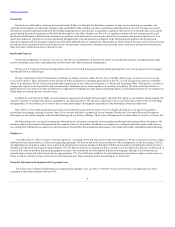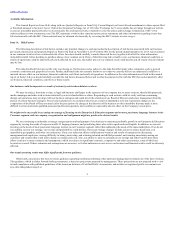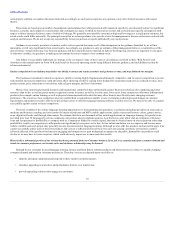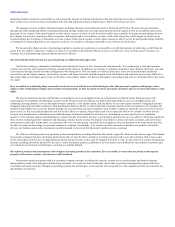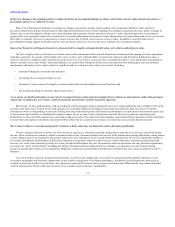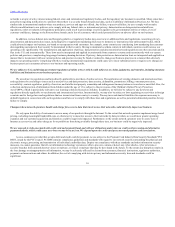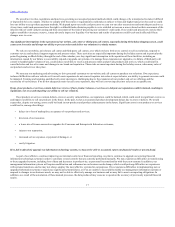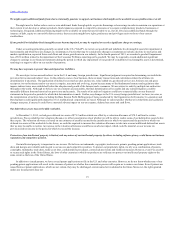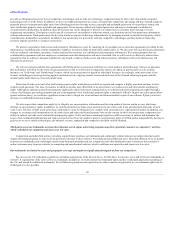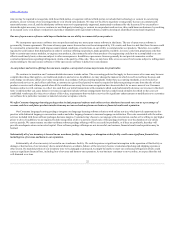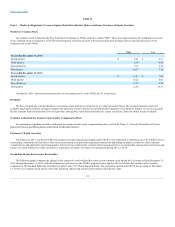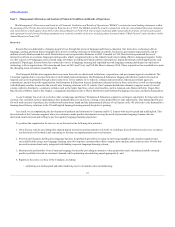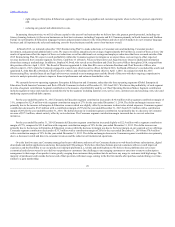Rosetta Stone 2015 Annual Report Download - page 19
Download and view the complete annual report
Please find page 19 of the 2015 Rosetta Stone annual report below. You can navigate through the pages in the report by either clicking on the pages listed below, or by using the keyword search tool below to find specific information within the annual report.
Table of Contents
Failure to maintain the availability of the systems, networks, databases and software required to operate and deliver our Internet-based products and
services could damage our reputation and cause us to lose revenue.
We rely on internal and external systems, networks and databases maintained by us and third-party providers to process customer orders, handle
customer service requests, and host and deliver our Internet-based learning solutions. Any damage, interruption or failure of our systems, networks and
databases could prevent us from processing customer orders and result in degradation or interruptions in delivery of our products and services.
Notwithstanding our efforts to protect against interruptions in the availability of our e-commerce websites and Internet-based products and services, we do
occasionally experience unplanned outages or technical difficulties. In addition, we do not have complete redundancy for all of our systems. In the event of
an interruption or system event we may be unable to meet contract service level requirements, or we could experience an unrecoverable loss of data which
could cause us to lose customers and could harm our reputation and cause us to face unexpected liabilities and expenses. If we continue to expand our
business, we will put additional strains on these systems. As we continue to move additional product features to online systems or place more of our business
online, all of these considerations will become more significant.
We may also need to grow, reconfigure or relocate our data centers in response to changing business needs, which may be costly and lead to unplanned
disruptions of service.
We may incur losses associated with currency fluctuations and may not be able to effectively hedge our exposure, which could impair our financial
performance.
Our operating results are subject to fluctuations in foreign currency exchange rates. We currently do not attempt to mitigate a portion of these risks
through foreign currency hedging, based on our judgment of the appropriate trade-offs among risk, opportunity and expense. In the future, we might choose
to engage in foreign currency hedging transactions, which would involve different risks and uncertainties.
Our revolving credit facility contains borrowing limitations and covenants and the failure to maintain a sufficient borrowing base or to comply with such
covenants could prevent us from borrowing funds, and could cause any outstanding debt to become immediately payable, which might adversely impact
our business.
Our revolving credit facility contains borrowing limitations based on a combination of our cash balance and eligible accounts receivable balances and
financial covenants currently applicable to us, as well as a number of restrictive covenants, including restrictions on incurring additional debt, making
investments and other restricted payments, selling assets, paying dividends and redeeming or repurchasing capital stock and debt, subject to certain
exceptions. Collectively, these borrowing limitations and covenants could constrain our ability to grow our business through acquisition or engage in other
transactions. During the term of our $25.0 million revolving credit facility, we are also subject to certain financial covenants that require us to maintain a
minimum liquidity amount and minimum financial performance requirements, as defined in the credit agreement. If we are not able to comply with all of
these covenants, for any reason, we would not be able to borrow funds under the facility, and some or all of any outstanding debt could become immediately
due and payable which could have a material adverse effect on our liquidity and ability to conduct our business.
A significant deterioration in our profitability and/or cash flow caused by prolonged economic instability could reduce our liquidity and/or impair our
financial ratios, and trigger a need to raise additional funds from the capital markets and/or renegotiate our banking covenants.
To the extent the economic difficulties continue, or worldwide economic conditions materially deteriorate, our revenue, profitability and cash flows
could be significantly reduced as customers would be unable to purchase products and services in the expected quantities and/or pay for them within normal
agreed terms. A liquidity shortfall may delay certain development initiatives or may expose us to a need to negotiate further funding. While we anticipate
that our existing cash and cash equivalents, together with availability under our existing revolving credit facility, cash balances and cash from operations,
will be sufficient to fund our operations for at least the next 12 months, we may need to raise additional capital to fund operations in the future or to finance
acquisitions. If we seek to raise additional capital in order to meet various objectives, including developing future technologies and services, increasing
working capital, acquiring businesses and responding to competitive pressures, capital may not be available on favorable terms or may not be available at all.
Lack of sufficient capital resources could significantly limit our ability to take advantage of business and strategic opportunities. Any additional capital
raised through the sale of equity securities would dilute our stock ownership. If adequate additional funds are not available, we may be required to delay,
reduce the scope of, or eliminate material parts of our business strategy, including potential additional acquisitions or development of new products, services
and technologies.
18


